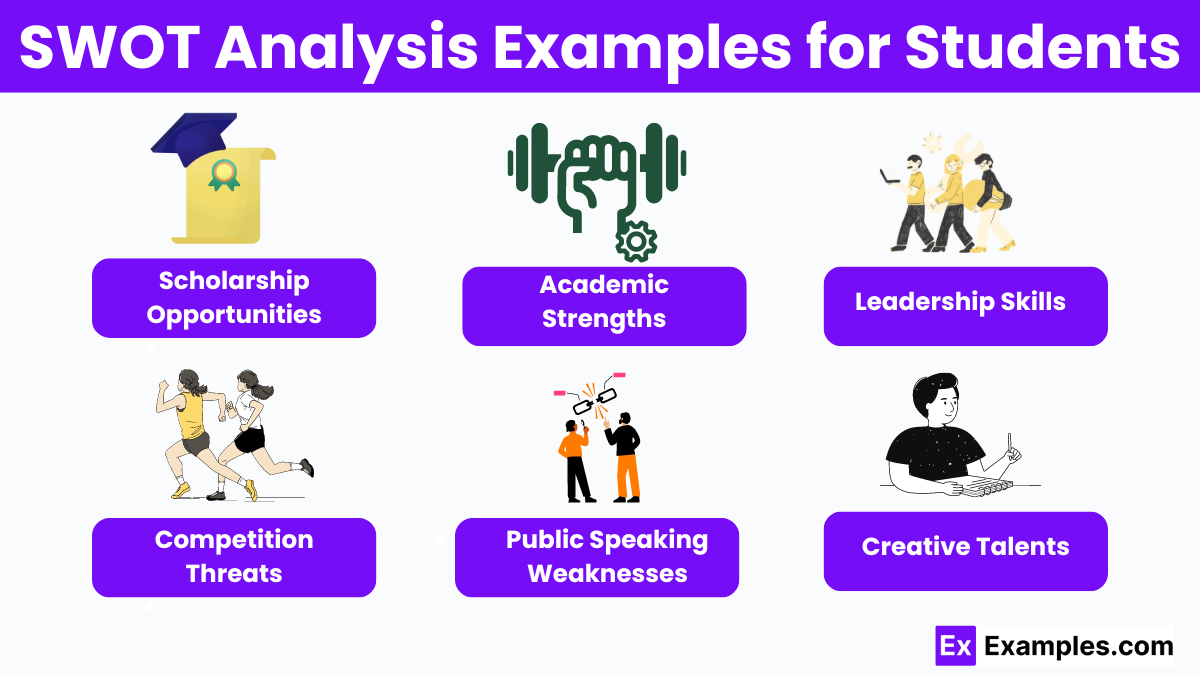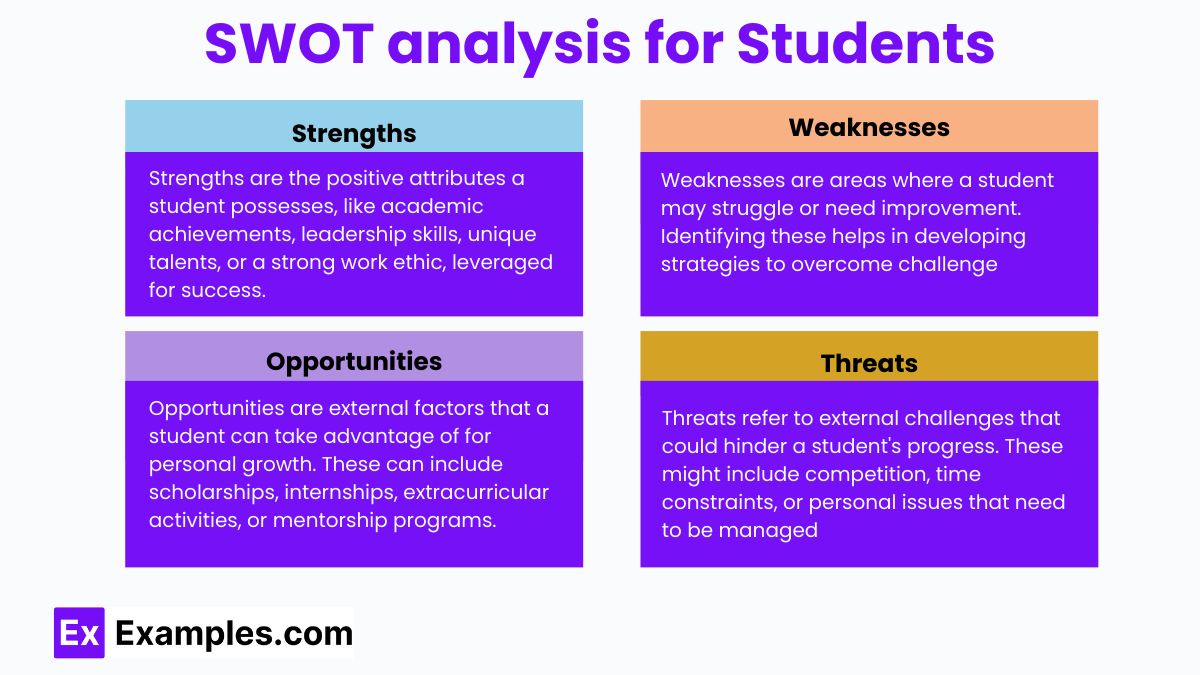10 SWOT analysis for Students Examples
SWOT analysis is a strategic planning tool that helps students identify their Strengths, Weaknesses, Opportunities, and Threats. This method is not only beneficial for personal development but also mirrors professional applications like Warehouse SWOT Analysis, Manager SWOT Analysis, Small Business SWOT Analysis, and Farm SWOT Analysis. By conducting a SWOT analysis, students can better understand their academic and personal growth areas, set realistic goals, and prepare for future challenges. This introspective tool aids in recognizing internal capabilities and external opportunities, ensuring students are well-prepared to navigate their educational journey and future career paths effectively. Conducting a SWOT analysis empowers students to maximize their potential and overcome obstacles.
What is SWOT analysis for Students
SWOT analysis for students is a strategic tool used to evaluate their Strengths, Weaknesses, Opportunities, and Threats. This self-assessment method helps students gain insights into their academic and personal abilities, identify areas for improvement, and recognize external opportunities and challenges. By understanding these factors, students can set realistic goals, make informed decisions about their education and career, and develop strategies to enhance their overall performance and personal growth. This process ultimately empowers students to achieve their full potential.
Why a SWOT Analysis is so important?
SWOT analysis is crucial as it helps identify Strengths, Weaknesses, Opportunities, and Threats in various contexts. For example, a Boutique SWOT Analysis can uncover unique selling points and market challenges, while a Hospital SWOT Analysis helps improve healthcare services and patient care. An Employee SWOT Analysis aids in personal development and career planning. By understanding these elements, individuals and organizations can make strategic decisions, improve performance, and capitalize on opportunities, ultimately leading to sustained success and growth.
What is a SWOT Analysis test as a student?
A SWOT Analysis test for students is a strategic tool that assesses individual Strengths, Weaknesses, Opportunities, and Threats. It helps students understand their capabilities, identify areas needing improvement, and develop strategies for personal and academic growth.
Strengths : Strengths in a Manager SWOT Analysis encompass positive attributes and skills crucial for effective leadership and performance. These may include academic achievements, strong work ethic, leadership skills, and unique talents, which can be leveraged to achieve success and excel in managerial roles.
Weaknesses : In a Small Business SWOT Analysis, weaknesses are areas where improvements are needed or where challenges may arise. Recognizing these aspects is crucial for developing strategies to overcome obstacles, enhance skills, and ultimately improve overall performance in both the business and personal spheres of life.
Opportunities : Opportunities are external factors that a student can take advantage of for personal growth. These can include scholarships, internships, extracurricular activities, networking events, or mentorship programs that provide valuable experiences and resources.
Threats : Threats refer to external challenges that could hinder a student’s progress. These might include competition, time constraints, financial issues, or personal problems that need to be managed to maintain focus and achieve goals.
How to Conduct a SWOT Analysis for a Student
- Gather Information: Start by collecting relevant information about the student. This can include academic records, extracurricular activities, feedback from teachers, and self-assessment to get a comprehensive view of the student’s performance and areas of interest.
- Identify Strengths: List the student’s strengths. Consider academic achievements, skills, talents, and positive personality traits. Strengths might include strong problem-solving skills, excellent time management, or leadership abilities that can be leveraged for success.
- Identify Weaknesses: Identify areas where the student struggles or needs improvement. This can include specific subjects, study habits, or personal traits such as procrastination, difficulty in certain subjects, or lack of focus and motivation.
- Identify Opportunities: Look for external opportunities that the student can leverage. These could be scholarships, internships, mentorship programs, or extracurricular activities that provide avenues for growth, learning, and development in various fields.
- Identify Threats: Identify potential external threats that could impact the student’s progress. These might include high competition, time constraints, financial issues, or personal challenges that need to be managed effectively to maintain focus and achieve goals.
- Analyze the Data: Once you have identified strengths, weaknesses, opportunities, and threats, analyze the data to understand how these elements interact. Look for ways to leverage strengths to seize opportunities and address weaknesses to mitigate threats.
- Develop an Action Plan: Create a detailed action plan based on the SWOT analysis. The plan should include specific goals, strategies to achieve them, and timelines. Ensure the student is involved to foster commitment and accountability.
- Review and Revise: Regularly review and update the SWOT analysis and the action plan. As the student progresses, new strengths and opportunities may arise, and new weaknesses or threats may need to be addressed to ensure continued growth.
Benefits of Conducting a SWOT Analysis for Students
| Benefit | Description |
|---|---|
| Self-Awareness | Helps students understand their strengths and weaknesses, fostering greater self-awareness and personal growth. |
| Goal Setting | Assists in setting realistic, achievable goals by recognizing opportunities and addressing potential threats. |
| Strategic Planning | Enables students to develop effective strategies for academic and personal success. |
| Improved Decision-Making | Provides a clear framework for making informed decisions regarding education and career paths. |
| Resource Utilization | Identifies resources and opportunities that students can leverage to enhance their learning and development. |
| Enhanced Problem-Solving Skills | Encourages critical thinking and problem-solving by analyzing internal and external factors affecting progress. |
| Motivation and Focus | Keeps students motivated and focused by clearly outlining their strengths and areas for improvement. |
| Adaptability | Helps students adapt to changing circumstances by anticipating potential challenges and preparing for them. |
10 SWOT Analysis Examples for Students

Academic Strengths : A student may excel in subjects like mathematics or science, showcasing strong analytical and problem-solving skills. These strengths can be leveraged for higher-level courses, advanced projects, and scholarship opportunities.
Time Management Weaknesses : A student may struggle with time management, often procrastinating on assignments and studying. Recognizing this weakness can help in developing strategies like creating a study schedule and using productivity tools to improve time management skills.
Scholarship Opportunities : Identifying available scholarships can present significant opportunities for students to fund their education. Applying for scholarships can also help students build a robust academic and extracurricular profile, enhancing their college applications.
Competition Threats : High competition in certain academic fields or extracurricular activities can pose a threat to a student’s success. Recognizing this can encourage students to develop unique skills or pursue niche interests to stand out.
Leadership Skills : A student who demonstrates strong leadership in clubs or group projects can use this strength to pursue leadership roles in college or future careers. Leadership experience also enhances college and job applications.
Public Speaking Weaknesses : A student who finds public speaking challenging may need to work on building confidence and communication skills. Participating in debate clubs or public speaking courses can help mitigate this weakness.
Internship Opportunities : Internships provide practical experience and networking opportunities. Identifying and applying for internships related to a student’s field of interest can offer valuable insights and professional growth.
Financial Constraints Threats : Financial difficulties can threaten a student’s ability to continue their education. Identifying this threat early can prompt students to seek financial aid, part-time jobs, or cost-effective educational options.
Creative Talents : A student with strong creative talents in areas like writing, art, or music can leverage these strengths for scholarships, college applications, and career opportunities in creative fields.
Health and Well-being Weaknesses : Neglecting physical and mental health can be a significant weakness. Students must recognize the importance of a balanced lifestyle, incorporating regular exercise, healthy eating, and stress management techniques to maintain overall well-being.
What are examples of threats for students?
Increased competition for scholarships, family responsibilities, part-time jobs, and limited access to resources.
How can a SWOT analysis help in career planning?
It provides insights into a student’s strengths and opportunities, helping them choose a suitable career path and prepare for it effectively.
Can a SWOT analysis be used for personal development?
Yes, it helps students set personal goals, improve self-awareness, and develop strategies to overcome challenges.
How often should students conduct a SWOT analysis?
Regularly, such as at the start of each academic year or semester, or when facing significant changes or decisions.
How can students use their strengths to take advantage of opportunities?
By leveraging their skills and talents to participate in activities and programs that can enhance their academic and career prospects.
How can students address their weaknesses in a SWOT analysis?
By creating action plans to improve areas of weakness, such as seeking help from tutors or practicing better time management.
What role do teachers and mentors play in a student’s SWOT analysis?
They can provide valuable feedback and guidance, helping students accurately assess their strengths, weaknesses, opportunities, and threats.
Can a SWOT analysis help in improving academic performance?
Yes, by identifying strengths to build on and weaknesses to address, students can develop strategies to improve their academic performance.
How can students prioritize the factors identified in their SWOT analysis?
By evaluating the impact and importance of each factor and focusing on the most significant ones first.
What is the outcome of a SWOT analysis for students?
A clearer understanding of their abilities and challenges, along with a strategic plan to enhance their academic and personal development.
How can a SWOT analysis boost a student’s confidence?
By highlighting their strengths and opportunities, students can build confidence in their abilities and potential for success.


